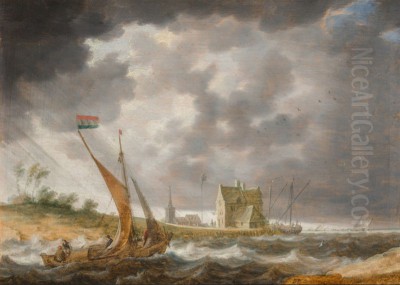
Bonaventura Peeters the Elder stands as one of the most significant marine painters of the Flemish Baroque era. Active during the vibrant and tumultuous 17th century, Peeters carved a distinct niche for himself by specializing in dramatic depictions of the sea, ships, and coastal life. Born in the bustling port city of Antwerp in 1614 and passing away relatively young in 1652, his career, though spanning less than two decades, left an indelible mark on the art of the Low Countries. He captured the power and poetry of the ocean, from tranquil harbors to terrifying tempests, with a skill that continues to captivate viewers today.
Peeters was not merely a painter of ships; he was an interpreter of the maritime world, reflecting the era's fascination with exploration, trade, naval power, and the sheer, untamable force of nature. His works offer a window into the dangers and romance associated with seafaring life during a period when the sea was both a vital highway for commerce and a frequent stage for conflict and disaster. His legacy is preserved in numerous paintings held by major museums worldwide, testament to his enduring importance in the history of art.
Early Life and Artistic Formation in Antwerp
Bonaventura Peeters was born in Antwerp on July 23, 1614. He hailed from a family deeply rooted in the arts; his father was also a painter, though less renowned. Artistry was a shared pursuit within the Peeters household. His older brother, Gillis Peeters I (1612–1653), and his younger sister, Catharina Peeters (1615–1676), also became accomplished painters, often working in similar genres, particularly marine and landscape painting. This familial environment undoubtedly fostered Bonaventura's early artistic inclinations.
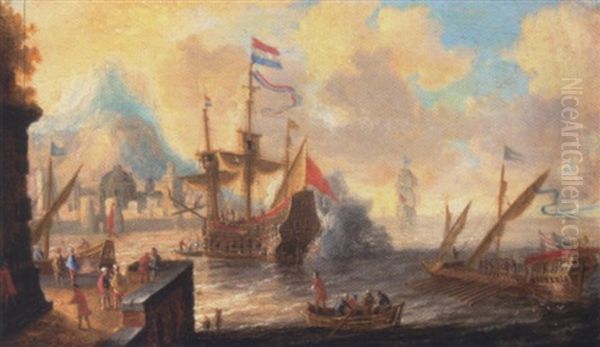
While specific details about his earliest training remain scarce, it is highly probable that he received initial instruction within the family circle. Antwerp, during the early 17th century, was a major European cultural hub, still basking in the artistic glow ignited by masters like Peter Paul Rubens and Anthony van Dyck. The city's Guild of Saint Luke, the official organization for painters and other craftsmen, was a central institution in its artistic life. Bonaventura Peeters became a master in the Antwerp Guild in 1634, a formal recognition of his professional standing.
Early influences on his work likely included the slightly older Antwerp marine painter Andries van Eertvelt (1590–1652), known for his often dramatic and colorful depictions of sea battles and storms, sometimes seen as carrying echoes of Mannerism into the Baroque. Peeters would absorb these influences but soon develop his own distinct approach to marine art, blending Flemish dynamism with emerging trends towards greater naturalism.
The Development of a Marine Specialist
In the art world of the Low Countries, specialization was common. While some artists tackled diverse subjects, many focused on specific genres like portraiture, still life, landscape, or, in Peeters' case, marine painting. Although the Dutch Republic to the north saw a veritable explosion of marine art with figures like Jan Porcellis and Simon de Vlieger pioneering tonal and atmospheric approaches, dedicated marine specialists were somewhat rarer in the Spanish Netherlands (Flanders). Peeters became the preeminent Flemish marine painter of his generation.
His early works sometimes show the brighter palette and somewhat more stylized wave patterns associated with predecessors like Van Eertvelt. However, Peeters quickly evolved. He demonstrated a keen observational skill, particularly in rendering the complex interplay of light, water, and sky. He became adept at capturing the specific details of different types of vessels – warships, merchantmen, fishing boats – reflecting the maritime traffic crucial to Antwerp and the Scheldt estuary.
Peeters' specialization set him apart in the Antwerp scene, which was dominated by history painting, portraiture, and genre scenes led by figures like Jacob Jordaens and David Teniers the Younger. His focus on the sea provided a different kind of drama and narrative potential, tapping into the anxieties and aspirations tied to maritime endeavors.
Style and Technique: Capturing the Drama of the Sea
Bonaventura Peeters is perhaps best known for his dramatic and often turbulent seascapes. He excelled at depicting ships battling fierce storms, waves crashing against rocky coastlines, and the harrowing spectacle of shipwrecks. These scenes are characterized by dynamic compositions, strong contrasts of light and shadow (chiaroscuro), and a palpable sense of movement and energy. He masterfully rendered the texture of churning water, the spray of the waves, and the dramatic cloud formations of approaching or receding storms.
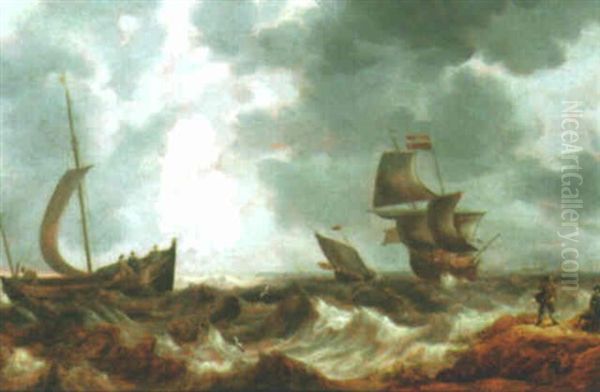
His use of color evolved. While some earlier pieces retain a brighter, more localized palette, many of his mature works exhibit a more subtle, tonal harmony, perhaps reflecting the influence of Dutch contemporaries like Simon de Vlieger, whose work he clearly knew. However, Peeters often retained a stronger narrative and dramatic element compared to the more atmospheric focus of many Dutch marine painters. He skillfully balanced realism in the depiction of ships and rigging with an almost theatrical staging of events.
Peeters paid meticulous attention to detail. The flags and pennants identifying the nationality or allegiance of ships, the figures of sailors scrambling in the rigging or struggling in the water, the specific architectural features of identifiable ports – all contribute to the richness and credibility of his scenes. This precision suggests not only careful study but possibly personal experience with the sea, although documented evidence of extensive voyages is limited. His ability to convey the vulnerability of wooden ships against the immense power of the elements remains one of the most compelling aspects of his art.
Themes and Subjects: From Local Waters to Exotic Shores
Thematically, Peeters' work encompassed a wide range of maritime subjects. Storms and shipwrecks were recurrent themes, allowing him to explore dramatic narratives and the sublime power of nature. He depicted naval battles and skirmishes, reflecting the ongoing conflicts of the period, such as the Eighty Years' War between Spain and the Dutch Republic. Calm seascapes and harbor views provided a contrast, showcasing tranquil waters, ships at anchor, and the bustling activity of ports.
His geographical scope was notably broad. He frequently painted scenes set along the coast of Flanders and the Scheldt estuary, the waterway connecting Antwerp to the North Sea. However, his imagination and likely his source materials (perhaps prints or travel accounts) took him much further afield. Peeters developed a particular taste for exotic and faraway locations. He painted views of Mediterranean ports, sometimes identifiable, sometimes seemingly fantastical combinations of Southern European and Middle Eastern architecture.
Works depicting Scandinavian coastlines, often characterized by dramatic fjords and rocky shores under snow or ice, also feature in his oeuvre. These scenes, like his depictions of Middle Eastern or Levantine ports, often blend topographical accuracy with imaginative elements, catering to a growing European interest in distant lands and cultures. Paintings like The Port of Archangel (1644) show his willingness to tackle specific, remote locations known through trade routes. This fascination with the exotic adds another layer to his work, positioning him not just as a painter of the local sea but as a visual chronicler of a wider, interconnected maritime world.
Collaboration and the Peeters Family Workshop
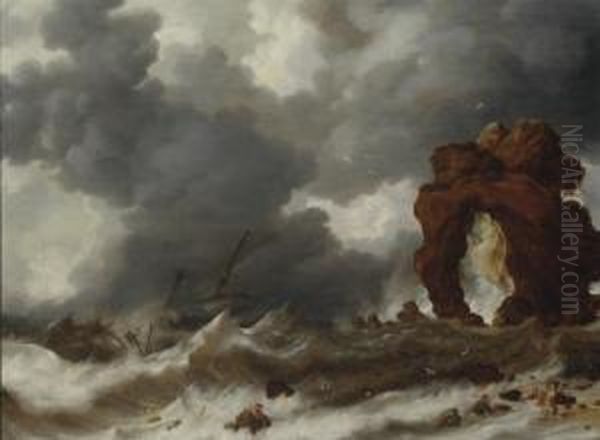
Artistic collaboration was common practice in 17th-century Antwerp, and the Peeters family provides a clear example. Bonaventura frequently worked alongside his siblings. He shared a studio with his brother Gillis Peeters I in Antwerp. Gillis was also a capable artist, often painting landscapes and marine views that sometimes resemble Bonaventura's style, leading to occasional attribution challenges for art historians.
Their collaboration extended to specific projects. For instance, they are known to have worked together on paintings related to the Battle of Calloo (1638), a significant military engagement near Antwerp. This might have involved creating large-scale depictions or maps related to the event, showcasing their versatility.
Their sister, Catharina Peeters, also specialized in marine paintings, often depicting dramatic storms and shipwrecks in a style clearly influenced by Bonaventura. Later in his career, particularly after moving from central Antwerp to the quieter suburb of Hoboken around 1641, Bonaventura continued to work closely with his family. His nephew, Jan Peeters I (1624–c. 1677), son of Gillis, became his pupil and a notable marine and landscape painter in his own right, continuing the family tradition and often depicting the Mediterranean and exotic scenes favored by his uncle. This family enterprise ensured the continuation of a specific style and thematic focus within Antwerp's art scene.
Key Works and Where to Find Them
Several paintings stand out as representative of Bonaventura Peeters' skill and thematic interests. While attribution can sometimes be complex due to the family workshop, key works generally credited to him include:
Shipping in a Storm off a Rocky Coast (various versions): This theme was a staple for Peeters, allowing him to showcase his mastery of depicting tumultuous seas, dramatic lighting, and the peril faced by ships. Examples can be found in museums like the National Maritime Museum in Greenwich, London.
The Siege of Calloo (c. 1639): Likely a collaborative work, perhaps with Gillis, depicting the Spanish victory near Antwerp. Such works combined marine elements with topographical and historical interests.
The Port of Archangel (1644): Held by the National Maritime Museum, Greenwich, this painting is a prime example of Peeters' interest in specific, distant ports, showcasing the Russian trading post with meticulous detail given to the ships and the wintry atmosphere.
View of Antwerp Harbour: Peeters depicted his home port numerous times, capturing the activity along the Scheldt river with its characteristic skyline.
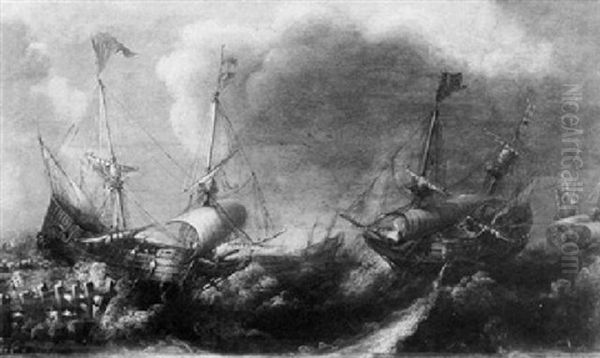
Dutch Ships in a Calm: Demonstrating his versatility, Peeters could also paint serene scenes, focusing on the reflections in still water and the majestic forms of ships at rest. Examples exist in collections like the Rijksmuseum, Amsterdam.
Mediterranean Harbour Scene: Many works depict imaginary or composite views of southern ports, often featuring galleys, elaborate architecture, and figures in exotic dress, highlighting his fascination with the Levant and Italy. These are found in various collections, including the Prado Museum in Madrid and the Hermitage Museum in Saint Petersburg.
His works are housed in major international museums, including the Royal Museum of Fine Arts in Antwerp, the Rijksmuseum in Amsterdam, the National Maritime Museum in Greenwich, the Louvre in Paris, the Prado in Madrid, the Hermitage in Saint Petersburg, and numerous other public and private collections across Europe and North America.
Influences and Contemporaries in a Vibrant Art World
Bonaventura Peeters operated within a rich artistic context. As mentioned, Andries van Eertvelt was an early influence in Antwerp. Peeters was also clearly aware of developments in the Dutch Republic, particularly the work of tonal marine painters like Jan Porcellis (c. 1584–1632), who revolutionized seascape painting with his atmospheric subtlety, and Simon de Vlieger (c. 1601–1653), known for his calm seas and detailed ship portraits as well as stormy scenes. Peeters seems to have absorbed aspects of their naturalism while retaining a distinct Flemish preference for drama and narrative clarity.
Within Antwerp itself, the towering figures were Peter Paul Rubens (1577–1640) and his immediate circle, including Anthony van Dyck (1599–1641) and Jacob Jordaens (1593–1678). While Peeters did not paint in their grand history painting style, the overall dynamism and painterly richness of the Antwerp school likely informed his approach. He would have also been contemporary with other specialists, such as the still life painter Frans Snyders (1579–1657) and landscape artists like Jan Wildens (1586–1653).
Later marine painters, particularly in Flanders, certainly looked to Peeters' work. His influence is most direct on his family members – Gillis I, Catharina, and Jan I – but his success in the genre helped solidify marine painting's place within the Flemish tradition. He can be seen as a bridge figure, connecting the earlier, more colorful style of Van Eertvelt with the growing trend towards realism, while prefiguring some of the dramatic intensity found in later Baroque art. He stands apart from the slightly later, highly influential Dutch marine specialists like Willem van de Velde the Elder (1611–1693) and his son Willem van de Velde the Younger (1633–1707), who developed a different, often more refined and detailed style, particularly in documenting naval events.
Later Years, Legacy, and the Absence of Anecdote
Around 1641, Bonaventura Peeters, along with his brother Gillis and possibly other family members, moved from the heart of Antwerp to nearby Hoboken, a village on the Scheldt river just south of the city. Contemporary sources suggest this move may have been prompted by health concerns. Peeters suffered from ill health in his later years, though the specific nature of his ailment is not recorded.
Despite these health issues, he continued to paint productively during the 1640s. His life appears to have been largely dedicated to his craft and his family. Unlike some artists of the period, no dramatic anecdotes, scandals, or extensive travelogues are associated with him. The available records depict a professional artist, active in his Guild, running a successful workshop with his siblings, and focused on producing high-quality marine paintings. He never married.
His life was cut short when he died in Hoboken on July 25, 1652, just two days after his 38th birthday. His relatively early death meant his period of artistic maturity was condensed, yet he produced a substantial body of work that secured his reputation.
Bonaventura Peeters the Elder's legacy lies in his position as the leading Flemish marine painter of the high Baroque. He masterfully combined detailed observation with dramatic composition, capturing the beauty, danger, and economic importance of the sea in the 17th century. His influence extended through his family workshop and provided a benchmark for marine painting in the Southern Netherlands. Today, his works are admired for their technical skill, their evocative power, and the window they offer onto the maritime world of his time. He remains a key figure for understanding the diversity and richness of Flemish Baroque art beyond the towering presence of Rubens.